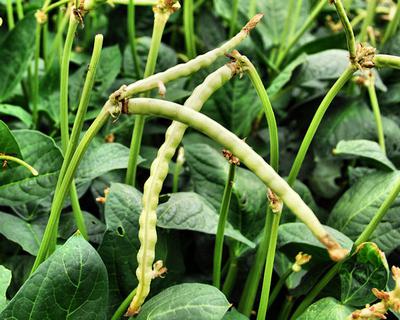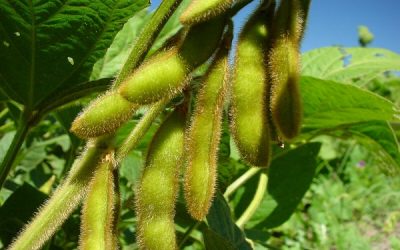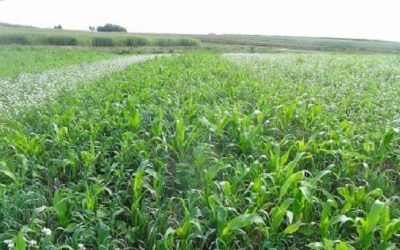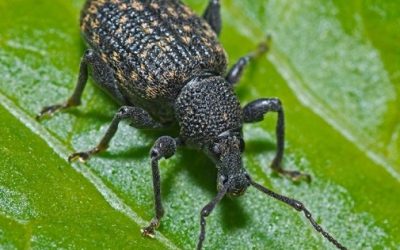Harvesting and post-harvest handling for Cowpeas.

Cowpeas vary in growth habit from erect or semi-erect types with short (<100 days) growth duration, grown mostly for grain, to longer (>120 days) duration in semi-erect to trailing plants which are normally grown primarily for forage. At maturity, leaves will dry down but may not drop off completely. They need to be harvested when seed moisture content is 14 to 18 %, depending on the consumer’s requirement. In cowpeas grown for vegetable purposes, the leaves are picked 4 weeks after planting, and this continues until the plants start to flower.
Harvesting Methods
Cowpea can be harvested using a harvester or by hand. The upright cultivars are easy to harvest by machine. Cowpea grown as a dried seed product can be direct combined, using a platform head or a row crop head. Adjustments to combine settings and possibly sieve sizes should be made for the cowpea seed. Because the pods are relatively long, some will touch the ground or be close to it, making it important to run the grain table close to the ground. In the case of cowpeas grown for vegetable purposes, young leaves are mainly picked by hand, older leaves accumulate dust or get spattered with mud from raindrops if not harvested.
Harvesting of cowpea in most cases should coincide with the onset of dry season when the dry pods can remain about a week awaiting harvesting without spoilage. However, to avoid field weathering or shattering, dry pods should not be left in the field longer than 2 weeks after full pod maturity. Harvesting can be carried out manually (hand harvesting) or by using a combine harvester in the case of largescale production.
Post-Harvest Handling
1. Sorting
Seed quality is important, so care in harvest and post-harvest handling is important to avoid cracked or split seed as such seeds which were allowed to dry on plant are harvested to ensure full maturity. Sorting is done to separate the broken seeds from the full seeds. Some buyers will want the seed cleaned and bagged, while others will take the grain in bulk form and clean it themselves.
2. Post-Harvest Handling
The leaves are dried to store for the dry season. Usually they are first steamed or boded, but not in all places. Sun-drying requires 1 to 3 days; storage for up to a year is possible because dried cooked leaves are not damaged to the same extent as by insects as dried seeds. Excessive losses of P-carotene, vitamin C, and the amino acid lysine often occur in sun-dried leaves, however, these can be reduced by minimal cooking followed by drying in the shade.
3. Grading
Usually the youngest leaves or tender shoots in the distinctive color phase of new growth are gathered. Young leaves are tender, usually higher in protein, and, lacking insect damage, often look more appealing. Older leaves accumulate dust or get
spattered with mud from raindrops, while younger leaves would not need so much washing.
4. Packing
Some buyers will want the seed cleaned and bagged, while others will take the grain in bulk form and clean it themselves. Packaged in sacks and put into electrical dryers or spread on a concrete slab in the case of sun drying in order to reduce the
moisture content to about 12 %.
5. Storage
Insect pests in particular can be devastating to cowpea during storage. There are storage insects that cause damage to the seed; it is therefore important to store seed in a protected place. A serious insect pest during storage is the cowpea weevil
Callosobruchus maculatus, (Coleoptera: Bruchidae). The rising popularity of organic produce lines has created interest in nonchemical disinfestation treatments as the use of chemicals in controlling these insects is becoming a problem.
The storage life of cowpea depends on its moisture content before storage. The lower the moisture content, the better the quality of seeds in storage. In developed countries; one alternative is the use of cold storage. An exposure to -18 °C during to 24 hours can reduce pest numbers by more than 99 %. The grain can be stored short term at around 12 % moisture or less, with 8 to 9% recommended for long-term storage. Cowpea leaves are dried to store them for the dry season. Sun-dried leaves
may store for up to a year because dried, cooked leaves are not damaged as much by insects as dried seeds.
6. Transport
For some markets, the cowpeas must be harvested at higher moisture, such as 18%, and trucked directly from the field to the processor and do not require specialised transportation for seed, however, it could be necessary for the leaf market to avoid
wilting.


